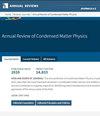Dry Aligning Dilute Active Matter
IF 30.7
1区 物理与天体物理
Q1 PHYSICS, CONDENSED MATTER
Annual Review of Condensed Matter Physics
Pub Date : 2020-03-10
DOI:10.1146/annurev-conmatphys-031119-050752
引用次数: 135
Abstract
Active matter physics is about systems in which energy is dissipated at some local level to produce work. This is a generic situation, particularly in the living world but not only. What is at stake is the understanding of the fascinating, sometimes counterintuitive, emerging phenomena observed, from collective motion in animal groups to in vitro dynamical self-organization of motor proteins and biofilaments. Dry aligning dilute active matter (DADAM) is a corner of the multidimensional, fast-growing domain of active matter that has both historical and theoretical importance for the entire field. This restrictive setting only involves self-propulsion/activity, alignment, and noise, yet unexpected collective properties can emerge from it. This review provides a personal but synthetic and coherent overview of DADAM, focusing on the collective-level phenomenology of simple active particle models representing basic classes of systems and on the solutions of the continuous hydrodynamic theories that can be derived from them. The obvious fact that orientational order is advected by the aligning active particles at play is shown to be at the root of the most striking properties of DADAM systems: ( a) direct transitions to orientational order are not observed; ( b) instead generic phase separation occurs with a coexistence phase involving inhomogeneous nonlinear structures; ( c) orientational order, which can be long range even in two dimensions, is accompanied by long-range correlations and anomalous fluctuations; ( d) defects are not point-like, topologically bound objects.干燥对准稀释活性物质
活性物质物理学是关于能量在某个局部水平上耗散以产生功的系统。这是一种普遍的情况,特别是在生活世界中,但不仅如此。关键是要理解观察到的令人着迷、有时甚至违反直觉的新兴现象,从动物群体的集体运动到运动蛋白和生物膜的体外动态自组织。干排列稀释活性物质(DADAM)是活性物质多维、快速增长领域的一个角落,对整个领域具有历史和理论重要性。这种限制性设置只涉及自我推进/活动、对齐和噪音,但可能会产生意想不到的集体特性。这篇综述提供了DADAM的个人但综合和连贯的概述,专注于代表基本系统类别的简单活性粒子模型的集体水平现象学,以及可以从中导出的连续流体动力学理论的解。定向有序被排列的活性粒子所促进这一明显事实被证明是DADAM系统最引人注目的特性的根源:(a)没有观察到向定向有序的直接转变;(b)相反,一般的相分离发生在涉及不均匀非线性结构的共存相中;(c)定向有序,即使在二维也可能是长程的,伴随着长程相关性和异常波动;(d)缺陷不是点状的、拓扑约束的对象。
本文章由计算机程序翻译,如有差异,请以英文原文为准。
求助全文
约1分钟内获得全文
求助全文
来源期刊

Annual Review of Condensed Matter Physics
PHYSICS, CONDENSED MATTER-
CiteScore
47.40
自引率
0.90%
发文量
27
期刊介绍:
Since its inception in 2010, the Annual Review of Condensed Matter Physics has been chronicling significant advancements in the field and its related subjects. By highlighting recent developments and offering critical evaluations, the journal actively contributes to the ongoing discourse in condensed matter physics. The latest volume of the journal has transitioned from gated access to open access, facilitated by Annual Reviews' Subscribe to Open initiative. Under this program, all articles are now published under a CC BY license, ensuring broader accessibility and dissemination of knowledge.
 求助内容:
求助内容: 应助结果提醒方式:
应助结果提醒方式:


